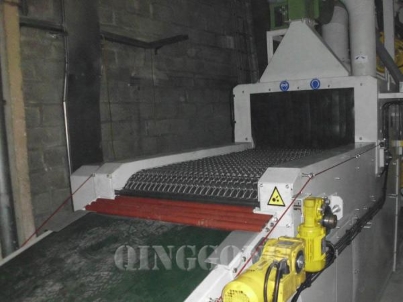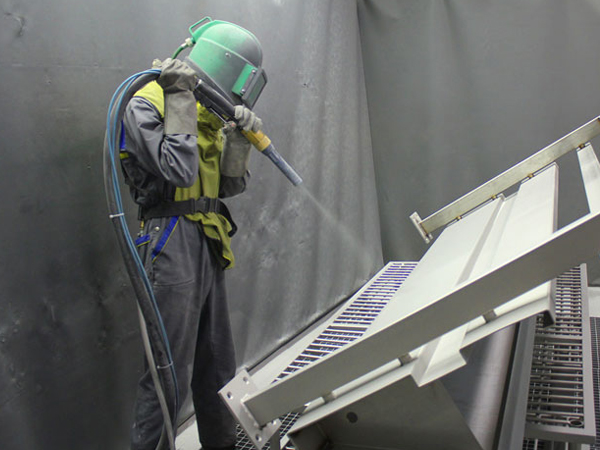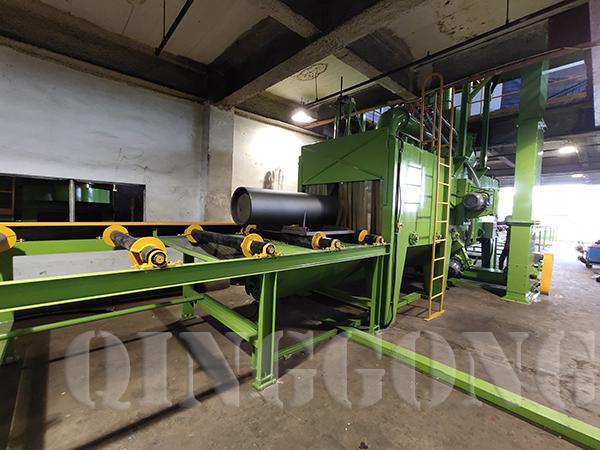Principle of collision
Steel shots are alloy particles with a certain mass. Under the action of the rotating force of the shot blaster, the steel shots are thrown toward the bogie at a certain speed, so that the steel shots collide with the bogie. During the collision, the force generated by the steel shot is F = (mv1-mv0)/(t1-t0), which is the change in the momentum of the steel shot per unit time. Among them, m represents the mass of the steel shot; 130 is the initial speed of the steel shot; UI is the speed when the steel shot contacts the bogie; to refers to the start time of the action; t refers to the end time of the action. This force acts on the oxide layer (rust), dirt and paint on the metal surface of the bogie, separating it from the metal surface of the bogie and showing the metal surface itself. In the collision between the steel shot and the bogie, the quality of the bogie and its components is much greater than the quality of the steel shot, so the steel shot is thrown by the shot blaster and acts on the bogie, then it pops up at the speed of contact and act on another part of the bogie. In this way, the number of times a steel shot particle acts on the bogie is much greater than one.
The vehicle bogie is composed of frame, spring and other parts. The appearance is complex, and there are many covering surfaces. It is a point that the steel shot acts on the bogie. This point is insignificant for the bogie. However, from a probabilistic point of view, if the number of steel shots thrown per revolution of the shot blaster is in contact with the bogie and the area covered is 1/50-1/100, and the speed of the shot blaster is 1400 r/min, then the contact area of the bogie within the shot angle of the shot blaster must be completely covered. When the turntable carrying the bogie rotates at a speed of 1 r/min or reciprocates in a single row once/min, its surface coverage can reach 100%. The contact between the steel shot and the bogie surface is a collection of points, that is, a point-plane relationship. The irregularity of steel shots and the uncountability of the number of shots make the area of the contact point tend to be the surface area of the bogie, and make the point collision tend to be the surface collision. With the extension of the shot blasting time, the collision area can be covered multiple times. The area of the bogie directly opposite to the shot angle of the shot blaster can be completely covered. So, how to solve the occlusion surface? It has been mentioned in the collision principle that due to the collision between the steel shot and the bogie, the rebound effect causes the steel shot to contact all parts of the bogie (although the force after the rebound has weakened, it can still play a role in the collision ), including the covering surface of parts. In order to compensate for the reduction of the rebound force of the steel shot and the reduction of the contact surface of the rebound particles, the adjustment is made on the action time, that is, the number of rotations of the bearing turntable or the number of reciprocating movements is increased. Finally, the oxide (rust), dirt and paint on the surface of the bogie are separated from the metal surface by collision, and the purpose of cleaning the surface of the bogie is achieved.
Firstly, test it on a shot blasting machine for metal surfaces of small parts. The workpiece is in a rolling state, the shot blaster is placed on top, and the four faces of the accessory (according to the hexahedron for example) are covered by the shot angle of the shot blaster. Moreover, since the surface corresponding to the other two surfaces of the accessory of the metal shot blasting machine is a side steel plate, each part (that is, six surfaces) of the steel pellet in contact with the accessory is in contact with the steel pellet. Practice has proved that the surface of any shape of accessories can be impacted by steel shots to achieve the purpose of surface cleaning.
Secondly, based on the test of the small shot blasting machine, the shot blasting device for vehicle bogies was developed based on the principle and technology of metal shot blasting. The device adopts the rotation mode and the speed is 4 r/min. A blasting device is installed on the side of the cleaning machine, and the blasting angle covers the height of the bogie. Two shot blasting devices are installed on the upper part of the cleaning machine to reduce the height of the cleaning machine and the coverage area is larger than the area covered by the bogie slewing radius. The upper part of the bogie supporting turntable is a wear-resistant steel plate. Through the test, the shot blasting machine works for 8 minutes, and the metal oxides, dirt and paint on the surface of each part of the bogie can be completely cleaned.
 EN
EN
 fr
fr  de
de  es
es  it
it  ru
ru  pt
pt  ar
ar  th
th  pl
pl  ro
ro 


